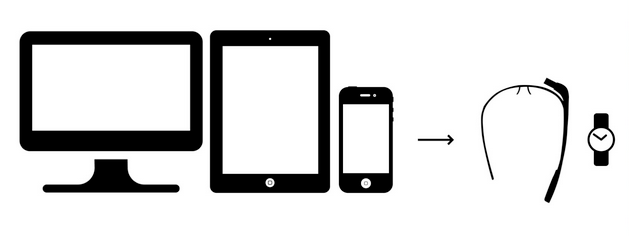Morse

With wearable devices on the rise, small screen and no-screen user experience is a hot topic. We’ve been witnessing powerhouses in industrial and technical design take on the problem over the last two years, but the market’s response continues to be lackluster. What is it about this format is holding us back?
On the one hand, some argue that the limited screen size means we can only show very little information at a time. It’s tantamount to wearing hundreds of dollars of technology for what amounts to a status-bar. Some tech enthusiasts make the plunge readily, but the price and limited offerings are clearly a barrier to most. Most recently Apple made a wild attempt to drive new use cases into their release by spelling out oddball new interactions. Their idea, it seems, is to overwhelm their audience with these nonsensical uses until they overlook the fact that the device is no more powerful than a fitbit glued to a swatch.
I empathize with that stance. Small screens do have innate problems finding useful interactions. Still, the cell phone had a similar issue as well before industry rose to meet the challenge. How long ago was it when playing a game with a friend required being face-to-face, or at least on a desktop? The immediacy of our interactions blended to meet the challenge of the interface quickly as ingenuity spread virally across the medium. That’s why I believe the real challenge to wearables is not in the size of their screen, but rather in the size of their input.
RSVP, or rapid serial visual presentation, gives users an alternate way of taking in text that is at once futuristic and suddenly familiar. By flashing one word quickly in place of another, our eyes pick up the flow of a sentence, paragraph, and so on automatically but without wasting all the time tracking from one place on a screen to another. RSVP has been around for years, but gained internet fame when Spritz introduced their demo a few months ago. Already their technology has found its way into smart watches, handheld applications and web plugins. Familiarity and ease-of-use combine quickly before our eyes as one of the key challenges of the small screen is tackled.
What then of input, though? Where are our tiny keyboards? Microsoft is trying pretty much anything they can think of at this point. We’ve had incredibly smart folks working on how to turn handwriting into text since the 80s (and maybe earlier). Will this finally be the push that makes it happen? Perhaps we’ll see a new type of keyboard emerge that meshes the all-popular Swipe with our small interfaces. One thing is abundantly clear. QWERTY is not getting it done.
We should not expect to see a keyboard interface as we know it on our watches or goggles. The challenge on mobile phones was enough to take us through the world of T9 and other predictive text implementations and out again into the world of quick thumbs. I really can’t say where we’re going to end up with any certainty, but there’s one part of the puzzle I find incredibly frustrating. Our best and brightest seem to feel that introducing a new interface or even a comepletely new input style is not a big deal for end users, and yet they ignore altogether one alternate input method that we’ve been using successfully for over a hundred years. Morse Code.
Dots and dashes. Tap and longer tap. The method is there, easy to use, and blindingly fast with the meagerest of practice. So maybe it’s a bit more intimidating than writing out each letter with your fingernail, but remember we don’t need to listen to it anymore, just input. The small screen and RSVP style feedback can show us the results in plain text. We just need to be able to put our thoughts down quickly, and without distractions. You don’t even need to look at your screen to use morse code. Does it need work? Likely. I wouldn’t want to put the same HAM radio style shortcuts and rigamarole into a consumer level interface. How about our smart friends at Samsung, Sony, Apple and so on task a few of their brilliant minds with making Morse for the Masses.